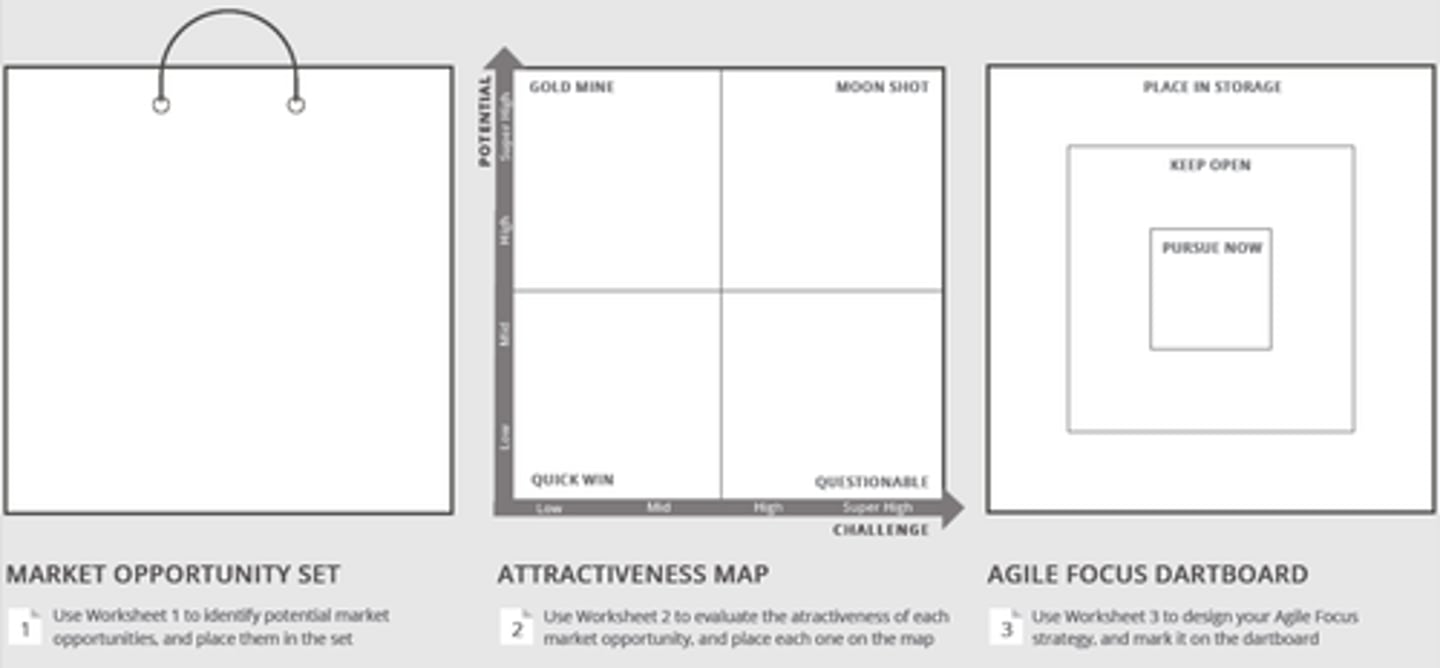Data Driven Business Creation | Quizlet
1/17
There's no tags or description
Looks like no tags are added yet.
Name | Mastery | Learn | Test | Matching | Spaced |
|---|
No study sessions yet.
18 Terms
5 building blocks of Lean Startup Framework
1. Finding and prioritizing market opportunities
2. Designing business models
3. Validated learning (including customer development)
4. Building Minimal Viable Products (MVP's)
5. Persevere or pivot from current course of action
Market opportunity
A specific application of your firm's abilities for a specific set of customers.
4 categories of opportunities
1. Gold mines, easy and rewarding
2. Quick wins, easy but not very rewarding
3. Moon shots, difficult but rewarding
4. Questionable, difficult and not very rewarding (avoid)
5 objective evaluation criteria
1. Desirability, do customers want it?
2. Feasibility, could we build it?
3. Viability, could we make money from it?
4. Usability, will it be user-friendly?
5. Adaptability, can we change it?
3 requirements of a hypothesis
1. Testable, can be shown to be True/False based on evidence
2. Precise, should be known what Success or Failure looks like
3. Discrete, should only be about one thing you want to test
3 capabilities that are important for firms to create value over longer time periods (Achtenhagen et al., 2013)
1. A willingness to experiment with and deploy new business opportunities
2. A balanced use of resources
3. Coherence between leadership, company and employees
4 revenue models
1. Freemium
2. On demand, instantly meet need and take small share (Uber)
3. Platform
4. Subscription
Signaling theory
Actions of a company or it's insiders send informational signals to investors about the firm's underlying quality or future prospects—especially when there is asymmetric information.
Social exchange theory
How people evaluate the costs and benefits of a relationship they could enter. Can be economic or social.
9 Elements of the Business Model Canvas
1. Customer segments
2. Value propositions
3. Channels
4. Customer relationships
5. Revenue streams
6. Key resources
7. Key activities
8. Key partnerships
9. Cost structure
4 sources of value creation through business models
1. Novelty (Spotify)
2. Lock-in (Apple Ecosystem)
3. Complementarities (Microsoft Office)
4. Efficiency (IKEA)
Open innovation
Companies do not only look at internal ideas but also at external sources of ideas to improve their business (P&G Swiffer)
Collaborative entrepreneurship
The creation of something of economic value based on new jointly generated ideas that emerge from the sharing of information and knowledge (Apple+Nike shoe sensor)
3 opportunities the Lean Startup provides for business model innovation
1. Enabling continuous experimentation in organizations
2. Enabling the development of novel and impactful business models that have the support of both internal and external stakeholders
3. Can be potentially integrated with other decision-making approaches to turn promising ideas into viable business models
3 steps of the Market Opportunity Navigator
1. Search broadly, generate your market opportunity set
2. Assess deeply, create your attractiveness map
3. Strategize smartly, create your agile focus

PESTEL Analysis
Framework or tool used by marketers to analyze and monitor the macro-environmental factors that have an impact on an organization, company, or industry. Political, Economic, Social, Technological, Ecological and Legal.
The Wizard of Oz
A type of MVP test where customers believe they are interacting with an automated system (but they are not, with a 'wizard' behind the scenes instead)
Wird gerade gelernt (9)
Diese Begriffe lernst du gerade. Immer weiter so!